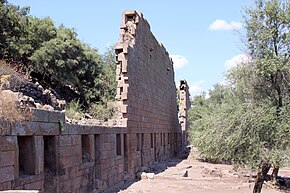Aigai (Aeolian)
| Αἰγαί, Αἰγαῖαι (Ancient Greek) | |

Facade of Aigai's market hall
|
|
| Alternate name | Aigaiai |
|---|---|
| Location | Yuntdağı Köseler, Manisa Province, Turkey |
| Region | Aeolis |
| Coordinates | 38°49′52″N 27°11′19″E / 38.83111°N 27.18861°ECoordinates: 38°49′52″N 27°11′19″E / 38.83111°N 27.18861°E |
| Type | Settlement |
| Site notes | |
| Condition | Ruins |
| Ownership | Public |
| Public access | Yes |
Aigai, also Aigaiai (Ancient Greek: Αἰγαί or Αἰγαῖαι; Latin: Aegae or Aegaeae; Turkish: Nemrutkale or Nemrut Kalesi) was an ancient Greek, later Roman (Ægæ, Aegae), city and bishopric in Aeolis. Aegae is mentioned by both Herodotus and Strabo as being a member of the Aeolian dodecapolis. It was also an important sanctuary of Apollo. Aigai had its brightest period under the Attalid dynasty, which ruled from nearby Pergamon in the 3rd and 2nd century BC.
The remains of the city are located near the modern village of Yuntdağı Köseler in Manisa Province, Turkey. The archaeological site is situated at a rather high altitude almost on top of Mount Gün (Dağı), part of the mountain chain of Yunt (Dağları).
Initially the city was a possession of the Lydian Empire and later the Achaemenid Empire when it conquered the former. In the early third century BC it became part of the Kingdom of Pergamon. It changed hands from Pergamon to the Seleucid Empire, but was recaptured by Attalus I of Pergamon in 218 BC.
In the war between Bithynia and Pergamon, it was destroyed by Prusias II of Bithynia in 156 BC. After a peace was brokered by the Romans, the city was compensated with hundred talents. Under the rule of Pergamon a market building and a temple to Apollo were constructed.
...
Wikipedia

